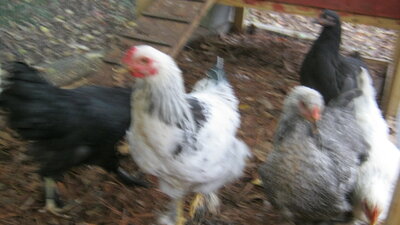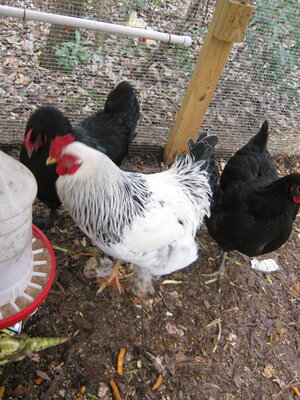“What kind of chickens should I get?”
That’s probably the backyard chicken newbie’s most common question and the hardest to answer. Yes, there are practical things to consider, but when you get to the heart of it the answer is almost always, “What kind of chickens do you like?”
When you’re new what you like today may not be the same as what you like next year. That’s OK.
Some people are perfectly content to leave it up to chance by getting whatever the farm store has on a given day or by ordering a hatchery choice assortment -- which is a good way to try out multiple breeds for a discount price. Others want to make a choice but don’t know how to narrow down the options because all chickens sound amazing in their hatchery-catalog descriptions.
So, where to begin?
First, what do you want chickens for? Meat? Eggs? Gardening? Showing? Lawn Ornaments? Pets?
Any chicken can be eaten -- even the tiniest bantams and the black-fleshed fibromelanistic breeds. Young cockerels of the dual-purpose and layer breeds won’t be as meaty, but are perfectly tasty when cooked correctly according to their age while retired hens make the best chicken and dumplings on earth. However, if meat is your primary interest you’ll want either Cornish X or one of the “ranger” type broilers that are bred to grow rapidly to slaughter weight while efficiently converting feed to flesh.
Beyond that,
Any layer or dual-purpose breed and most of the ornamental breeds will provide you with amazingly-delicious eggs in reasonable quantities and some will flood you out with so many eggs that you’ll end up stuffing them into neighbors’ mailboxes like overgrown zucchini in a lush summer. At least in the springtime -- production is likely to slow down the rest of the year and may grind to a halt in the winter. So, unless you need maximum production for egg sales, you can feel free to pick whatever hens you like the looks of and enjoy an abundance of eggs in season -- for the first year.
Hens are likely to stop laying and molt in their second fall and then to lay larger but fewer eggs the next year, with production falling off faster or slower after that. If you want a continued generous supply you’ll need to cycle your hens. Replacing a third of the flock every year is a common strategy.
Any chicken will be delighted to weed, fertilize, and dig up your fallow garden beds when penned into the area where those activities are wanted. Any chicken will also be delighted to dig up, eat, and otherwise destroy your garden and landscape plants. Some people claim that feather-footed breeds do less damage when let out to roam the yard and garden, but those people haven’t seen my Brahmas excavating dust-bath holes deep enough to allow them to sink down to the level of their backs in a single afternoon.
The greatest contribution chickens make to gardening is providing their poop as fertilizer. All chicken breeds poop so you can feel free to pick whatever chickens appeal to you and enjoy the compost. Some people keep the compost pile inside the pen for convenience -- though the chickens are likely to scatter it around and require you to re-pile it from time to time.
Showing chickens is less about which breed you choose to show than about the quality of the birds you breed for showing. While the show world undoubtedly has it’s fads and fashions, the process of creating a quality line is going to be a long-term, hands-on process that involves spending a lot of time with and on your birds so this, maybe more than any other aspect of chicken-keeping, justifies keeping the chickens that you like the looks of best.
Showing is a beauty contest which, at it’s best, involves bringing a line of birds up to an elevated standard of gorgeous health and vigor. It’s probably theoretically possible to do this for a breed you don’t find especially appealing, but I can’t imagine why you’d want to.
Some people just like to have some chickens running around the property for the beauty of it. They like getting some eggs and the benefits of pest control but they get their main enjoyment from their feathery pets’ beauty and the interest they take in chicken behavior. Like showing, this is it’s own justification for choosing the prettiest chickens.
But what about those long lists of chickens suited for hot weather, cold weather, etc?
Yes, there are places with extreme climates where certain breeds might not do as well or might require some additional special care. Since I live in the Steamy Southeast of the United States I’ve avoided getting breeds such as Buckeyes and Chanteclers, which were specifically developed for cold-tolerance. A person who lives in an area that routinely sees extended periods of temperatures below-zero Fahrenheit should probably avoid breeds with large, single combs.
However, almost all layer or dual-purpose breeds and most ornamental breeds can be kept just about anywhere. Some, like feather-footed chickens in a wet climate on clay soil or very small bantams in areas with severe winters, might need extra care paid to their housing and maintenance, but for the most part chickens are tough, adaptable livestock and capable of thriving almost anywhere that humans do.
So go ahead and get the prettiest chickens. Give them roomy, predator-proof housing suited to your climate, plenty of fresh water, and an appropriate feed formulated for their age and laying status without treating them to too much chicken candy and they’ll reward you with eggs, fertilizer, pest control, and endless episodes of Chicken TV.
The only problem will be figuring out which ones are the prettiest ones.





